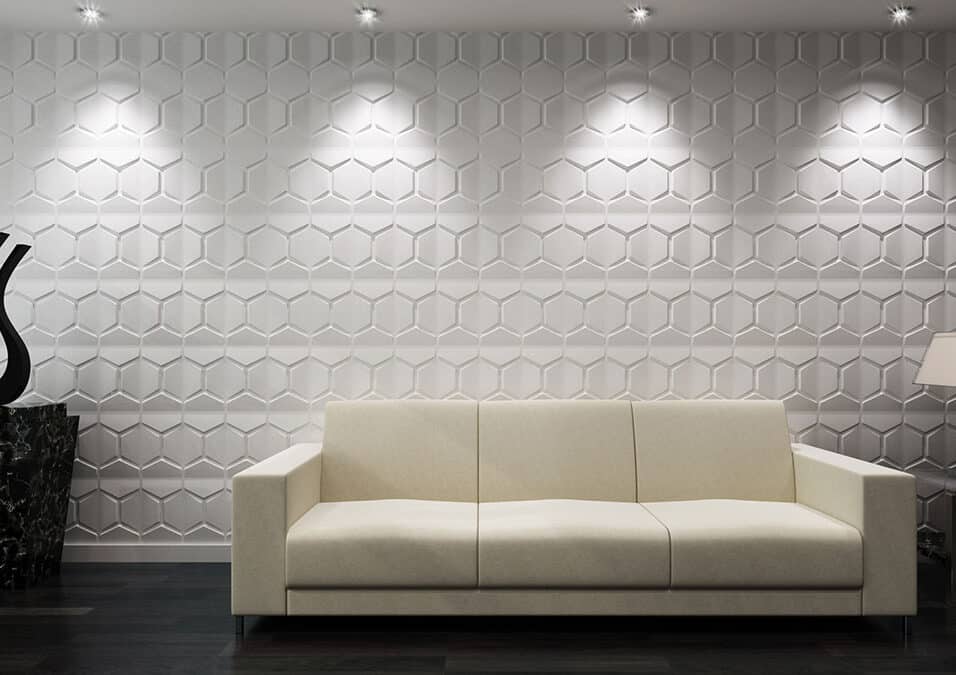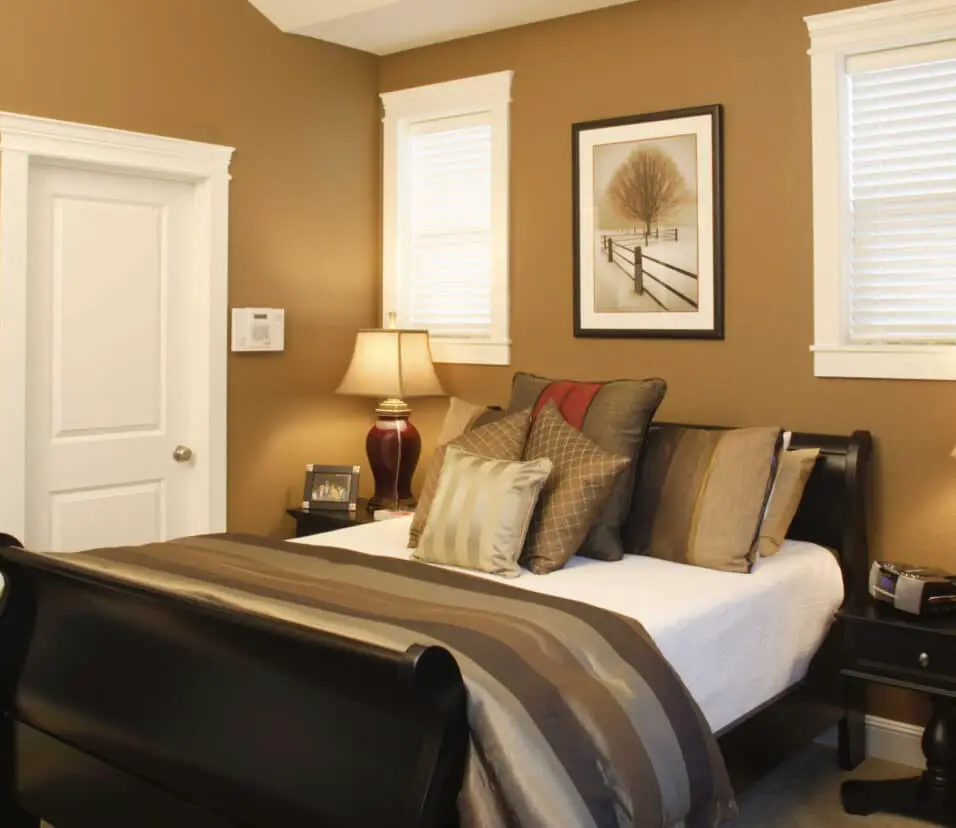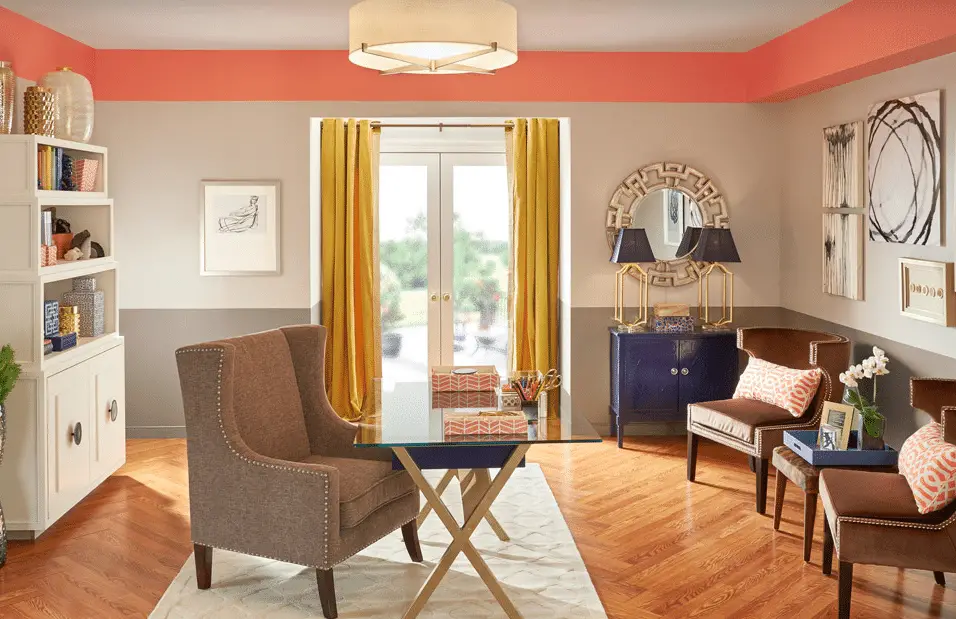What Is The Best Paint To Use On Interior Doors
Introduction
What Is The Best Paint To Use On Interior Doors: The right choice of paint for your interior doors not only revitalizes the overall ambiance of your home but also ensures durability and longevity. Selecting the best paint for interior doors involves considering various factors such as finish, color, and type of paint. This introduction aims to guide you through the process of choosing the ideal paint for your interior doors, helping you achieve a polished and inviting atmosphere that complements your home’s door interior design. Interior doors are not only functional elements of a home but also contribute significantly to its visual appeal. The choice of paint plays a pivotal role in achieving the desired look and feel. The best paint for interior doors strikes a balance between aesthetics, durability, and ease of application.
Equally important is the type of paint you choose. Water-based latex paints are popular for their low odor, quick drying time, and easy clean-up. They are also less likely to yellow over time compared to oil-based paints. However, oil-based paints are known for their durability and smooth finish. Newer formulations of water-based paints often provide the benefits of both types without the downsides. Preparation is key to a successful paint job.
Properly clean and sand the surface, and consider using a primer for better adhesion and color consistency. Invest in quality brushes and rollers to achieve a professional-looking finish. In this guide, we will explore various paint options, their pros and cons, and provide tips for achieving a flawless result. Whether you’re aiming for a modern, minimalist vibe or a cozy, traditional atmosphere, the right paint for your interior doors can help you achieve your design aspirations while ensuring lasting beauty.
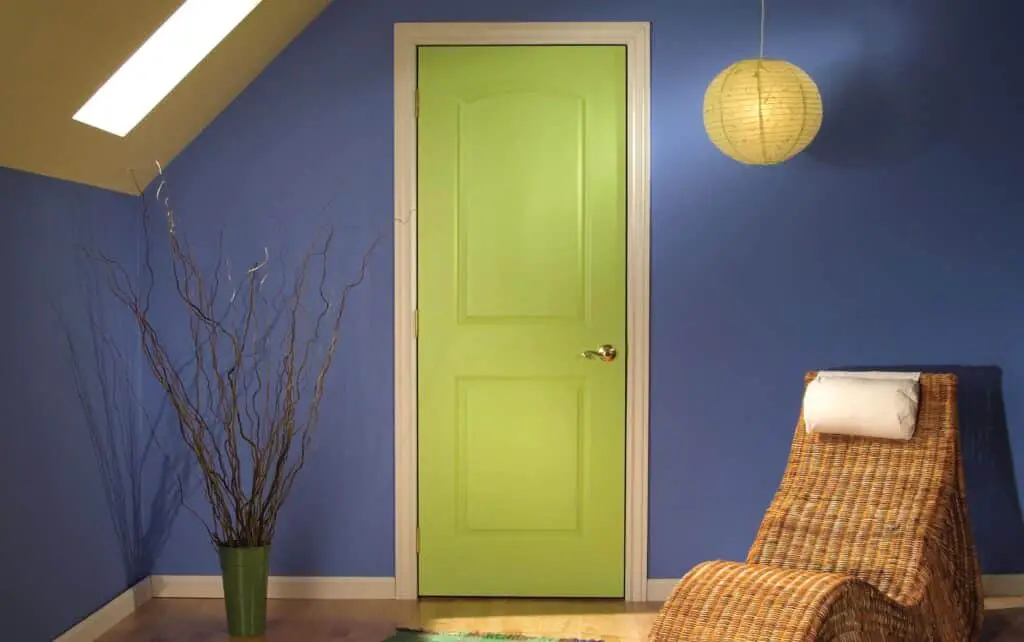
What kind of paint do you use on interior doors?
Acrylic paint
Exterior doors are typically painted with oil-based paint, while the best paint for interior doors generally is a latex-based or acrylic paint. You also need to choose the correct finish when painting interior doors: interior paints come in five basic finishes: flat, eggshell, satin, semi-gloss, and gloss.
Water-Based Latex Paint: Water-based latex paint is a popular choice for interior doors due to its versatility and ease of use. It has a quick drying time, low odor, and is easy to clean up with water. Latex paint also has the advantage of being less likely to yellow over time compared to oil-based paints. It comes in a wide range of colors and finishes, including matte, eggshell, satin, and semi-gloss.
Oil-Based Paint: Oil-based paint was once a common choice for interior doors due to its durability and smooth finish. It provides a hard and glossy surface that’s resistant to wear and tear. However, it has a longer drying time and requires mineral spirits for cleanup, making it less convenient than water-based options.
Hybrid Paints: Hybrid or waterborne alkyd paints combine the advantages of both water-based and oil-based paints. They offer the durability and smooth finish of oil-based paints without the associated drawbacks. These paints have a shorter drying time, low odor, and easy cleanup with water.
Chalk Paint: Chalk paint provides a matte, vintage look and is often chosen for a rustic or shabby-chic style. It requires minimal surface preparation and adheres well to various materials. However, it may require a protective topcoat for added durability.
What paint finish is best for interior doors?
Semigloss
Semigloss is the best paint finish for interior doors and trim. The reason being, semi-gloss can take up quite an abuse and stand up to nicks and scrapes better than any other sheen, flat or eggshell finish. The large surfaces gather dust just like your furniture.
Matte Finish: Matte finish, also known as flat finish, provides a non-reflective surface that creates a subtle, elegant look. It’s an excellent choice for hiding minor imperfections on doors, making it suitable for high-traffic areas or doors with visible flaws. However, keep in mind that matte finishes are generally less durable and can be more challenging to clean compared to glossier options.
Eggshell Finish: Eggshell finish strikes a balance between matte and gloss, offering a slight sheen that’s more durable than matte. It provides a subtle luster while still minimizing the appearance of imperfections. Eggshell is a popular choice for interior doors as it combines a visually pleasing appearance with reasonable durability.
Satin Finish: Satin finish is a step up from eggshell in terms of sheen and durability. It offers a smooth, velvety surface that’s easy to clean, making it suitable for doors in frequently used areas. Satin finishes strike a balance between hiding imperfections and providing a polished appearance.
Semi-Gloss Finish: Semi-gloss finish is known for its shine and resilience. It’s an excellent choice for interior doors, especially in spaces like kitchens, bathrooms, and children’s rooms. The reflective surface is not only visually appealing but also highly resistant to stains and easy to wipe clean.
What is the best type of paint for interior doors and trim?
The traditional choice for painting doors, trims and skirting boards has always been oil based gloss because it’s practical and hardwearing. Gloss paint holds up better for cleaning. Doors and the trims can get grubby which makes gloss type paints the preferred option, but some argue it’s outdated.
Water-Based Latex Paint
Water-based latex paint is a versatile and popular choice for both interior doors and trim. It offers several advantages that make it a go-to option for many homeowners. Latex paint dries quickly, has a low odor, and is easy to clean up with water. These features make it convenient for interior projects, especially in spaces where ventilation might be limited. Additionally, latex paint comes in a wide variety of colors and finishes, allowing you to customize the look of your doors and trim to match your interior design.
Hybrid or Waterborne Alkyd Paint
Hybrid paints, also known as waterborne alkyd paints, combine the best qualities of both water-based and oil-based paints. They offer the durability and smooth finish of oil-based paints without the drawbacks such as long drying times and strong odors. Hybrid paints are known for their excellent adhesion, easy cleanup with water, and resistance to yellowing. They provide a great compromise for those who desire the benefits of oil-based paints without the associated challenges.
Oil-Based Paint
While less common than in the past, oil-based paint remains a reliable choice for interior doors and trim, especially if durability is a top priority. Oil-based paints provide a glossy finish that’s exceptionally resilient and can withstand heavy use. However, they have a longer drying time and require mineral spirits for cleanup, making them less convenient compared to water-based options.
Do interior doors need special paint?
Choose paint recommended for interior doors, such as types with a durable gloss or semi gloss sheen that makes them easy to clean. If possible, paint in a well-ventilated area or use a fan to circulate the air. Before painting, clean the door with a degreasing cleaner.
Durability and Wear Resistance
Interior doors are subject to frequent use, including handling, opening, and closing. As a result, they are more prone to scuffs, scratches, and general wear. Using a paint specifically formulated for doors and trim ensures a tougher finish that can withstand these daily interactions. Regular wall paint may not provide the necessary level of protection, leading to premature wear and a less polished appearance over time.
Smooth and Polished Finish
Interior doors are typically more noticeable and prominent than walls, which makes achieving a smooth and flawless finish crucial. Paints designed for doors and trim often have better leveling properties, allowing them to cover the surface evenly and create a professional look. These paints tend to dry to a harder and glossier finish, enhancing the overall aesthetics.
Resilience to Cleaning and Maintenance
Doors are frequently touched and may accumulate dirt, fingerprints, and stains. Using a paint specifically intended for doors and trim ensures that the finish can be easily cleaned without getting damaged or losing its luster. Paints with higher sheen levels, like semi-gloss or gloss, are particularly adept at repelling stains and are easier to wipe down.
Color Consistency and Fade Resistance
The color on your interior doors should match or complement the overall design scheme of your home. Quality door and trim paints offer better color consistency, ensuring that the shade you choose looks the same from top to bottom. Additionally, these paints are formulated to resist fading, maintaining the vibrancy of the color over time.
Is there a special paint for doors?
Since your door will be exposed to rain, sun, wind and other elements, you’ll need a flexible and mold-resistant exterior paint. The most common kinds of exterior door paint are acrylic resin or latex-based and with a semi-gloss finish. Latex-based exterior paint is the most flexible type and is quite popular.
Durability and Wear Resistance
Doors are subjected to more physical contact and wear compared to walls. They are touched, bumped, and handle a significant amount of traffic. Special door paint is engineered to withstand these challenges, offering a more durable and resilient finish that is less prone to chipping, scuffing, and other forms of damage.
Smooth and Even Finish
Achieving a smooth and professional finish is crucial for doors, as they are focal points in a room. Door paints often have better leveling properties, which means they can cover surfaces more evenly, masking imperfections and providing a polished appearance.
Higher Sheen Options
Many door paints come in higher sheen levels, such as semi-gloss or gloss. These finishes not only add visual interest but also make the doors easier to clean and maintain. The higher sheen reflects light, giving the doors a distinct and inviting appearance.
Resistant to Stains and Marks
Door paint is designed to resist common stains, fingerprints, and smudges that accumulate from regular use. This feature is particularly important for doors in high-traffic areas or those exposed to children and pets.
Can I paint doors with wall paint?
Can I use the same paint for doors and walls? No, you will need to use different paint for walls and doors for the most professional-looking finish. Valspar’s Sarah Lloyd says: ‘Most doors are wooden so you’ll need an undercoat and primer. This is also true for painting front doors.
Durability and Wear Resistance
Doors are subject to more physical contact, including touching, bumping, and handling. They also experience more wear and tear compared to walls. Wall paint may not have the durability needed to withstand these challenges, leading to premature chipping, scuffing, and damage.
Smooth Finish
Achieving a smooth and professional finish is crucial for doors, as they are prominent elements in a room. Wall paint might not provide the same level of smoothness and even coverage as paints specifically designed for doors.
Cleaning and Maintenance
Doors are more prone to stains, fingerprints, and smudges due to their high-touch nature. Paints formulated for doors are often easier to clean and maintain, making them a practical choice for frequently used doors.
Sheen Levels
Many wall paints are available in matte or eggshell finishes. These finishes may not provide the ideal level of gloss or sheen for doors. Doors often benefit from higher sheen levels like semi-gloss or gloss, as they not only look more attractive but are also easier to clean.
Should interior doors be matt or gloss?
Matt – This finish is able to cover imperfections in the surface and application. It’s very easy and simple to touch up the finish if required.
Subtle Elegance: Matte finishes provide a soft, understated look that can create a sense of tranquility in a room. If you’re aiming for a minimalist or serene ambiance, matte doors can complement the design.
Camouflaging Imperfections: Matte finishes are excellent at hiding minor flaws and imperfections on the door’s surface. This makes them a practical choice for doors that may be subject to wear or have visible blemishes.
Sophistication: Matte finishes can exude a sense of sophistication and modernity, especially in contemporary or sleek interior designs.
Minimal Reflection: Matte doors reflect less light compared to gloss doors, which can contribute to a cozy and subdued atmosphere in a room.
What paint to use for white door?
If you’re painting your door white and have white trim around it, I recommend using the same paint color and finish as the trim. Some of my favorite whites for trim work and doors are Benjamin Moore’s Cloud White and Dove White in either semi-gloss or satin.
Type of Paint
Water-Based Latex Paint: This is a popular and practical choice for painting white doors. It offers a quick drying time, low odor, and easy cleanup with water. Latex paint also comes in a wide range of finishes, allowing you to choose the level of sheen that suits your preference, from matte to semi-gloss.
Hybrid or Waterborne Alkyd Paint: If you’re seeking a balance between the durability of oil-based paint and the convenience of latex paint, hybrid paints are a great option. They provide a durable finish, resist yellowing, and are relatively easier to work with compared to traditional oil-based paints.
Finish
Semi-Gloss or Gloss Finish: For white doors, a semi-gloss or gloss finish is often recommended. These finishes not only provide a sleek, polished look but also offer easy maintenance.
Durability and Resistance
Look for a paint that offers good durability and resistance to wear and tear. White doors can show dirt and imperfections more easily, so choosing a paint that can withstand daily use and cleaning is important.
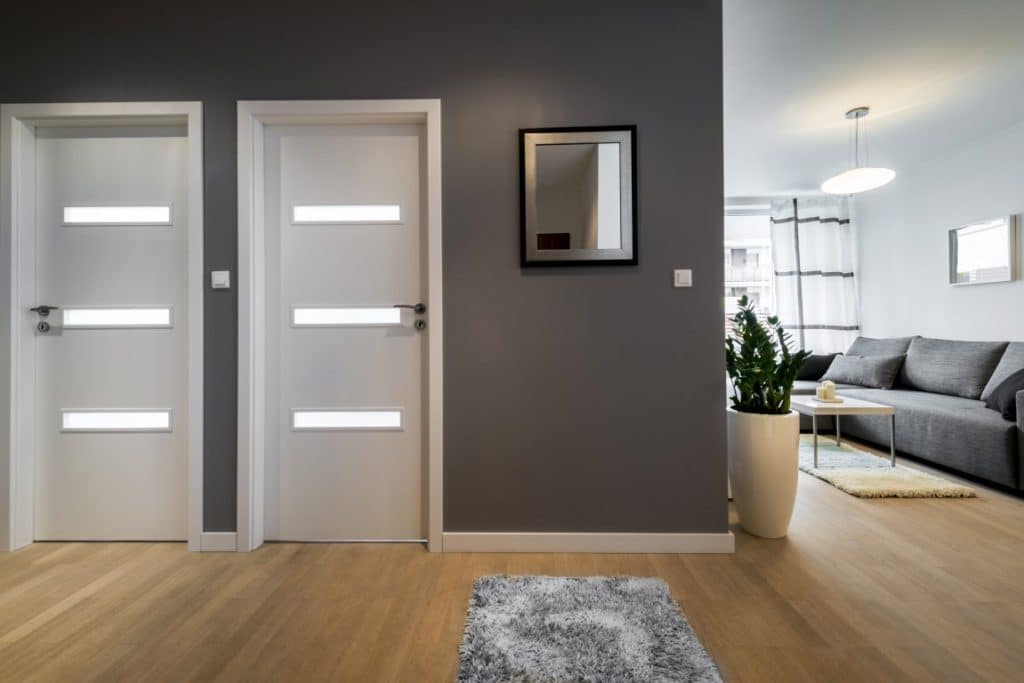
Conclusion
The appropriate paint finish, color, and type can improve your home’s appearance and leave a lasting impression. Color should blend with your home design, reflecting your style and adding to the room’s atmosphere. You should choose water-based latex or oil-based paint based on your priorities, such as drying time, odor, and durability. Some new paint compositions combine the best of both options. Paint job success depends on preparation, so clean and prime the surface. You may produce professional-looking effects that improve your home’s appearance using quality products and procedures.
It influences the longevity of your efforts, the ease of maintenance, and the overall vibrancy of the finish. Each brushstroke becomes a testament to your dedication to crafting a space that resonates with you. As you embark on this journey, remember that preparation and technique are as crucial as the paint interior itself. A meticulously cleaned and primed surface is a canvas ready to absorb your creativity. With the right tools and a dash of patience, you can transform your interior doors into seamless components of your home’s interior design.
In the grand symphony of home improvement, the choice of paint for interior doors plays a defining role. It harmonizes with the existing elements, sets the tone for each room, and unifies the overall experience. So, as you stand at this juncture of decision-making, embrace the fusion of your artistic inclination with the practical demands of your living space. With the right brush in hand and a vision in mind, your interior doors can become masterpieces that encapsulate the essence of your home.




